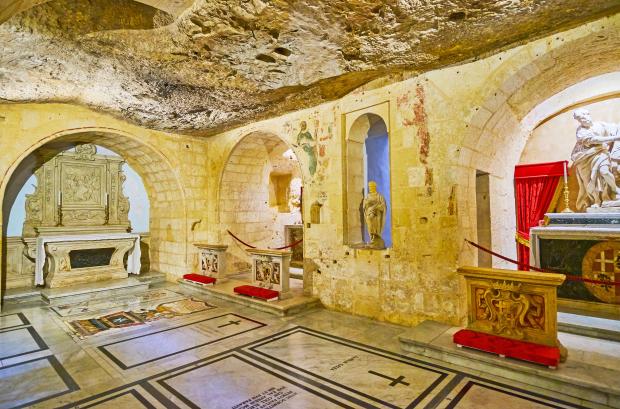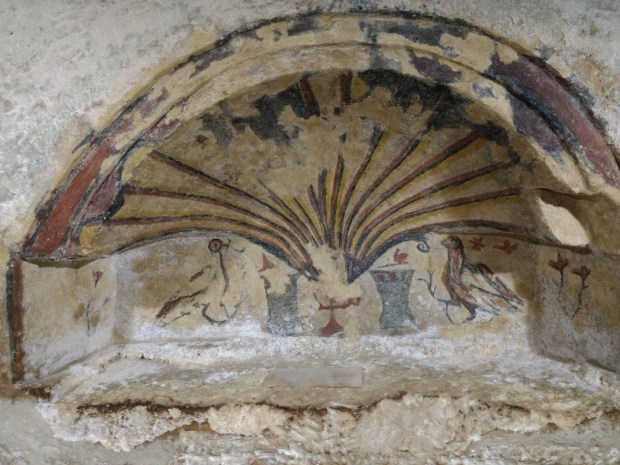“Of all the gifts brought to these shores in the course of your people’s history”, Pope Benedict XVI told the Maltese when he visited the country in 2010, “the gift brought by Paul was the greatest of all, and it is much to your credit that it was immediately accepted and treasured.” Benedict was referring to the famous passage in the book of Acts commonly referred to as Paul’s Shipwreck, and his meeting with Publius, the chief of the island who eventually became its first bishop. The text in Acts reads as follows:

Paul was shipwrecked off the northwestern coast of Malta on his way to trial in Rome in the year 60, and spent the unnavigable winter months there. It was during those three months when he established the very roots of Maltese Christianity —Christianity in the archipelago thus being as ancient as in Ephesus, Jerusalem, Corinth, and Rome itself. Aleteia had the opportunity to speak with professor Stanley Fiorini (Senior Research Fellow, University of Malta. Emeritus Professor of Mathematics) about this uninterrupted two-millennia long tradition of rich Christian heritage.

In spite of being featured in the Book of Acts, and of Paul’s shipwrecking and preaching in the archipelago, I dare say most Christians do not think of Malta as one of the early cradles of the Christian faith. It is documented, also, that Malta was one of the first Roman colonies to convert. There are then reasons to argue Malta can claim to have an uninterrupted 2000 years old Christian tradition. Why do you think this is not so well-known? Does it have to do with the many intricacies of Mediterranean history, like the ones you list in your article?
First of all, the minuscule size of the island (a mere 100 square miles and an overall population of at most 10.000) does not favor visibility. Furthermore, this aspect of Maltese history has been overshadowed by the more visible Neolithic or Temple Period overground and underground remains —which are indeed disproportionately numerous for the islands’ size. The fact that all these prehistoric, archaeological riches date back to 5.500 B.C. is also, incidentally, a reflection of our religiosity —albeit non-Christian in this case.
Even in Acts itself there is no record that Paul made conversions among the Maltese; he is merely documented for having performed many miracles of healing. But imagining the energetic, mercurial Paul sitting idle for three months twiddling his thumbs and not raising a finger to preach the Gospel is simply inviable. Unfortunately, to this day, you still find academics who do not accept as fact something anything not clearly stated black-on-white. This attitude suits them well in their attempt to refute some historical facts, such as the conversion of the island to Christianity by Paul, and the continuity of Christianity through the Arab period. I call these academics “latter-day iconoclasts.” Solid documentary evidence of the Pauline cult in these islands are the VI-century references to Gaudomelite (Melite of Gozo) in the apocryphal Acts of Peter and Paul, and the XII-century narrative in the anonymous Greek poem (published as Tristia ex Melitogaudo).
Christianity in the islands did not spread like fire; that much is true. We find evidence of pagan religions still doing well in the II century. Statues to Apollo were still being erected in Mdina. As elsewhere, the new religion began to come out in the open after Constantine’s edict of Milan in 313 A.D. Christian catacombs are known already from the IV century. In fact, the earliest and most prominent evidence for Christianity are the catacombs, with their characteristic agape tables. A later phase of semi-troglodytic churches becomes apparent in the VII century (namely, the Bormla Church of St Helen, and Tad-Dejr Byzantine basilica). Some lesser known (because in private hands) cave churches, like St George at Fawwara, have distinctive Roman features. Later manifestations in the first millennium are the Byzantine basilica and baptistry at Tas-Silġ, a Christian presence at the San Pawl Milqi complex, the clear existence of a Bishop of Malta in 553 A.D., and the four letters addressed to Malta’s bishops by Pope St Gregory the Great (592-603 A.D.)

In your article on the Arabs in Malta, you refer to some historical sources that claim the archipelago was deserted for more than a century, and that there might have been a certain discontinuity in Maltese Christian traditions. However, you claim some churches were to a certain extent respected, so a Christian population might have remained there. Can you say more about that?
Admittedly, the Church in Malta appears to have borne the brunt of the Islamic onslaught of 869, judging by its Bishop being found in jail in Palermo 8 years later, and that Qasr Habashi at Sousse in Tunisia was built with masonry from the church of Malta. The proponents of the theory that there was a break with Christianity during the years 869-1091 appeal to two main sources: 1) This period had been, until quite recently, archaeologically sterile, producing evidence for neither a Muslim nor a Christian presence; 2) the recent re-discovery by Maltese historians of the XIV-century text of Al-Himyari which states that after 869 these islands remained unpopulated for 180 years. This conclusion, if correct, has the obvious necessary corollary that ethnic discontinuity implies religious discontinuity, a fortiori.
For too long, medieval archaeology has been completely neglected as, also here, the focus of attention has been, mainly, the Temple (Paleo and Neolithic) Period. That explains “sterility:” no one had really looked for it. This is no longer the case. Medieval archaeologist Nathanael Cutajar and his collaborators have produced ceramic evidence for continued occupation and commercial activity in the IX and late X centuries. Furthermore, other researchers into the Holocene climate have analysed palinological data from sedimentary cores to bed-rock that show uninterrupted grain production in these islands from the Neolithic to the present, without any gaps. More recent interpretations of literary Arabic texts confirm this scenario (cf. Hitti, Ibn Idhari etc., in Fiorini / Zammit 2016 “Arab Malta” for details). Al Himyari’s “depopulation” is just hyperbolic language, typical of similar narratives of the period.
The most compelling argument for Christian continuity is the narrative, in the XII-century Greek poem Tristia ex Melitegaudo (ff. 84rv) describing Roger II’s attack on Melitegaudos (in 1127). The key verses (translated) read as follows:
It is clear that, in 1127, Roger II found a Christian community surrounding its bishop, that had been laboring under the Muslims, for whom they only had words of hatred. Having exiled their masters, Roger installed them in former mosques which he converted into churches. This community could not have been implanted by his father, Roger I, in 1091. If it had, then the Christians would have been free not servile second-class members of the island’s community (at best). It is recalled that the Christian slaves that came out to greet Roger I in 1091 with cries of “Kyrie eleison” were freed by the Count and sent back to their countries of origin. These other Christians were not slaves but resident Maltese second-class members of the community (called dhimmi). They had to be Greek, as the Latin influx from the continent only came later. It continued to flourish as evidenced by the Greek Protopapas Maltes, Nicolaos, who died in 1230 (whose wife Milas died in 1229). The Latin clergy (apart from the non-resident bishops whose see was in partibus infidelium) only begins to make an appearance in 1241.
This position has been mercilessly attacked in concert by Wettinger, Johns and Lauxtermann, whose objections I have rebutted in other articles (cf. Fiorini 2010 “Tristia revisited”; Fiorini / Vella 2015 “Truth vindicated”; and idem 2016 “Reactions”)

Historians often refer to Andalusia as an example of religious convivencia in the Mediterranean. We also know some of these claims are, to a certain extent, exaggerated or inaccurate. You also refer to Abdulrahman's dominion of Iberia in your article. Would you say Malta might have been a different case of such relatively cosmopolitan conviviality, based on its continuous Christian presence? And, if so, how exceptional would this be in the overall Mediterranean context?
The animus existing between the long-suffering Christians and Muslims, expressed in the gobbet just quoted, dismisses ideas of any convivencia. This hatred is not only attested to in this poem, but finds expression also in incidents such as the case of murder of a Saracen by the Christians of Malta and of Gozo, a crime for which they were penalized by King Roger and were only pardoned in 1198 by Roger’s daughter, Queen Constanza. Also, worth recalling is the meaning of ‘Malti’, the hated jailor in Andalucia, described in Ibn Quzman Muhammad’s poem of ca. 1150. It seems to have been the case that, in Andalucia, Christian jailers were employed to guard Muslim prisoners, as these would tend to sympathize less with them than their co-religionists; a Maltese jailer would be particularly valuable if he also spoke Arabic. (Cf. S. Fiorini and H.C.R. Vella, ‘New XIIth-century evidence for the Pauline tradition and Christianity in the Maltese Islands’: The Cult of St Paul in the Christian Churches and in the Maltese Tradition, ed. J. Azzopardi, (Malta: PEG 2006) 168.)

Is there any basis to claim some of the berbers and Arabs populating Malta were themselves Christian? Is there any archaeological evidence that might point at this that you know of?
Not to my knowledge if, that is, you are referring to pre-1200, but recall that a census of 1241 breaks down the population of 10,000 into 4,374 Christians and 5,626 Muslims (apart from a few Jews), of which the Christians constituted 55% of the Gozitan population and only 40.8% of the Maltese population.
By 1250, the year of death of Frederick II, the Muslims had been wiped out with those who stuck to their faith being exiled to Lucera (Maltese individuals can be identified among the exiles in Lucera in 1300), and the ones who stayed had to convert. You cannot explain otherwise the continuity of the Arabic language in Malta (as opposed to Sicily) and the profusion of Arabo-Berber placenames. These converts, who had everything to lose by remaining Muslim, must be the progenitors of the present Maltese people bearing hundreds of Arabo-Berber surnames, like Bugeia, Busuttil, Buhagiar (Abu-type surnames, that is), Sammut, Zammit, Borg, Abdilla, and several others. Especial attention to be given to Mohammed, which by the mid-XV century had already metamorphosed into a camouflaged Mamo. Other surname changes are visible when it ceased to be safe on the island to be called Dejf (Magro), Bsajla (Cipolla), Rqiq (Subtili) and others. Luttrell makes the perspicacious comment that the proliferation of countryside chapels – a chapel for every 25 persons – can only be explained as brandishing the Christian banner on the owner’s fields.



